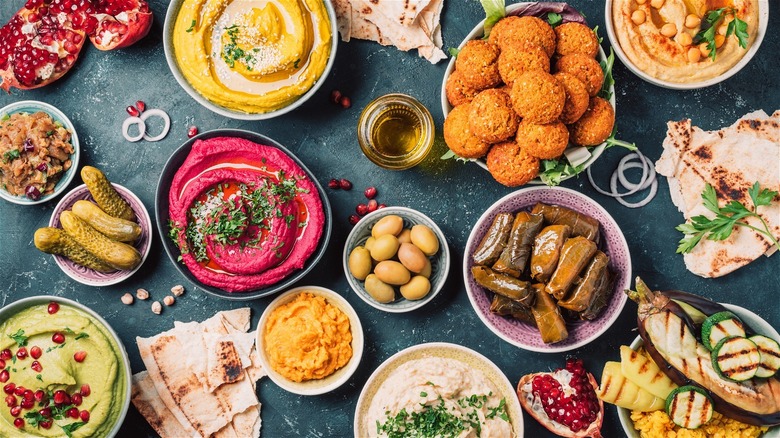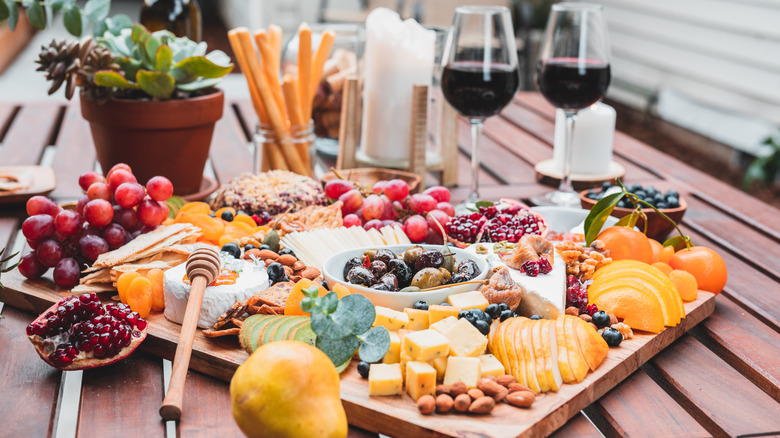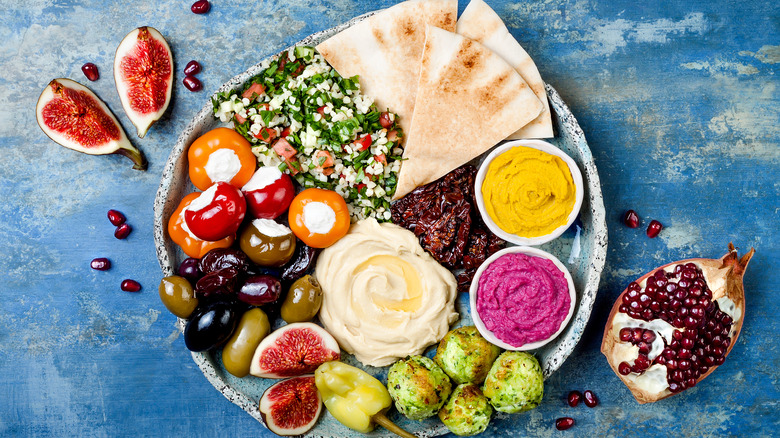The Difference Between Charcuterie And Mezze
This weekend, when you set out an elegantly arranged snack tray for your friends, should you call it a "charcuterie board" or a "mezze platter"? The short answer: If your smorgasbord focuses on cured meats and sliced cheeses, it's closer to a charcuterie. If your components are dips and small portions of appetizer foods that needed preparation, it resembles a mezze platter.
The longer answer? It's a lot more complicated than that because the spike in appetizer-board popularity has people taking liberties with the samplers they lay out and the labels they give their concoctions. Of course, that's fun and fine. However, if you are looking to elevate your cocktail-hour conversation with cultural and historical snack-tray gravitas, here are the incidentals that will keep your mezze appropriately stemming from the former Ottoman Empire and your charcuterie correctly mimicking the French "charcutiers" who bumped up leftover meats from scraps to the cured nibbles we love.
To begin, we rule out other snack trays of significance, like tapas platters (we're not talking about these) or antipasti (that's plural — "antipasto" is singular), or even, simply, hors d'oeuvres (trust me, everything has its own story to tell). Nailing a perfect charcuterie board vs. mezze platter is its own win for the weekend.
Each starts with a particular food focus. Charcuterie boards were historically all about the cured meat, Nicole Andrews, charcuterie curator for The Rustic Board, told Mashed, while mezze elements tend to be cooked and include dips. Let's drill down from there.
Charcuterie boards – origin, elements & what to tell your friends about your board's authenticity
Although cheese goes back centuries (maybe to 1200 B.C. — allegedly a feta-esque substance was found in an Egyptian tomb) and Romans preserved meat using salt in the first century, the innovation of the charcuterie boards like we see today belongs to the French. The word itself, derived from the French "chair cuit" means (brace yourself) "cooked flesh." According to Andrews, charcuterie was a means of minimizing any discarded bits of the animal. "Over time, cheese has joined the party. Charcuterie boards today will often include both."
To keep your charcuterie authentic by World Charcuterie Award standards, your meats should be pork products. Original charcutiers from 15th century France were shops that had the permits required to cure bacon, ham, sausage — everything from pork. As for cheese choices, Andrews said she focuses on a balance of great textures and flavors, like pairing a "bloomy rind such as a Brie, a semi-hard like Manchego and a harder crumbly aged cheddar." To go particularly French, she sticks with a creamy D'Affinois Brie, Etorki, and Comte.
Personal chef turned food blogger Molly Madigan told Mashed that she recommends a Roquefort for her charcuterie boards. If you're thinking of including a goat cheese in your spread, Madigan loves "a round goat cheese with a thin edible rind and a center just the tiniest bit runny." That, plus a modern addition of fruits, olives, and nuts makes charcuterie-board perfection.
Mezze platter – origin, elements & what to tell your friends about your platter's authenticity
You say "mezze"? Mezeh Mediterranean Grill says "mezeh," "maza," "meze," and "mazze." Why? The word "mezze" is likely an amalgamation of the various regions of the former Ottoman Empire, which stretches from the Balkans to Greece to other borders of the Mediterranean Sea. The word may have come from the Persian word "mez;" the Turkish word "meze," which means "snack;" the Arabic "mazmiz;" or from the Assyrian "mez."
With that as an opener, you know nailing down the authentic elements of this cuisine tradition will be tough. "A mezze platter typically consists of a bunch of small plates of prepared foods, like humus or salads," wrote Madigan, and those elements vary by region. Ina Garten's Greek mezze, for example, includes marinated herb feta, red peppers, and humus while a more Lebanese mezza has baba ghanoush with tahini dip.
A mezze platter often includes a mix of warm and cold items, from roasted eggplant to pickled artichokes and cucumber slices to a centerpiece salad, like tabouli. According to Suzy Karadsheh of The Mediterranean Dish, you'll want to keep your mezze platter unpretentious. The point is meaningful sharing, lingering, laughing, and bonding over food elements that invite you into a cultural experience that carries on historically rich hospitality and conviviality. Her feelings about a mezze platter in two words? "Intimate" and "plentiful." A most wonderful set of words to kick off a weekend with friends.


